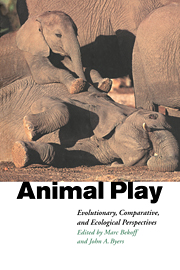Book contents
- Frontmatter
- Contents
- List of contributors
- Introduction
- 1 The evolutionary origins of play revisited: lessons from turtles
- 2 Play in common ravens (Corvus corax)
- 3 Object play by adult animals
- 4 Kangaroos at play: play behaviour in the Macropodoidea
- 5 Intentional communication and social play: how and why animals negotiate and agree to play
- 6 Structure-function interface in the analysis of play fighting
- 7 Sparring as play in young pronghorn males
- 8 Squirrel monkey play fighting: making the case for a cognitive training function for play
- 9 Self assessment in juvenile play
- 10 Biological effects of locomotor play: getting into shape, or something more specific?
- 11 Neurobiological sustrates of play behavior: glimpses into the structure and function of mammalian playfulness
- 12 Play as an organizing principle: clinical evidence and personal observations
- Index
2 - Play in common ravens (Corvus corax)
Published online by Cambridge University Press: 20 November 2009
- Frontmatter
- Contents
- List of contributors
- Introduction
- 1 The evolutionary origins of play revisited: lessons from turtles
- 2 Play in common ravens (Corvus corax)
- 3 Object play by adult animals
- 4 Kangaroos at play: play behaviour in the Macropodoidea
- 5 Intentional communication and social play: how and why animals negotiate and agree to play
- 6 Structure-function interface in the analysis of play fighting
- 7 Sparring as play in young pronghorn males
- 8 Squirrel monkey play fighting: making the case for a cognitive training function for play
- 9 Self assessment in juvenile play
- 10 Biological effects of locomotor play: getting into shape, or something more specific?
- 11 Neurobiological sustrates of play behavior: glimpses into the structure and function of mammalian playfulness
- 12 Play as an organizing principle: clinical evidence and personal observations
- Index
Summary
Among birds, the most common types of play (locomotor, object and social) are found in those orders (Psittaciformes and Passeriformes) with the most developed forebrains (Ortega & Bekoff 1987). Among the Passeriformes, the corvids are considered to have the most complex play behavior (Ficken 1977). The raven, Corvus corax is the largest passerine and probably has the largest brain volume of any corvid. It also inhabits the greatest geographical range and the most diverse habitats. The raven may therefore be expected to show tremendous behavioral flexibility, perhaps acquired in part through play (Gwinner 1966, Ficken 1977, Ortega & Bekoff 1987). Given these considerations, ravens provide a particularly useful ‘outgroup’ for comparison with mammals, as well as other birds.
In putting together this review of raven play behavior however, we were faced immediately with the problem of defining ‘play’. ‘Play’ is notoriously difficult to define (Fagen 1981, Bekoff & Byers 1981, Bekoff 1984, Martin & Caro 1985; see also Bekoff & Allen, Chapter 5). We all recognize it at the extremes, but cannot define it clearly enough to fit it into an exclusive and objectively defined category of behavior. Ficken (1977) points out, and we agree, that play is even more difficult to identify in birds than in mammalian species. Perhaps the most widely accepted definition of play is as follows: ‘…all motor activity performed postnatally that appears purposeless, in which motor patterns from other contexts may often be used in modified forms or altered sequencing’ (Bekoff 1984). This definition seems problematic in that it is not clear what is meant by ‘appears purposeless,’ and is therefore very difficult to apply.
- Type
- Chapter
- Information
- Animal PlayEvolutionary, Comparative and Ecological Perspectives, pp. 27 - 44Publisher: Cambridge University PressPrint publication year: 1998
- 24
- Cited by

